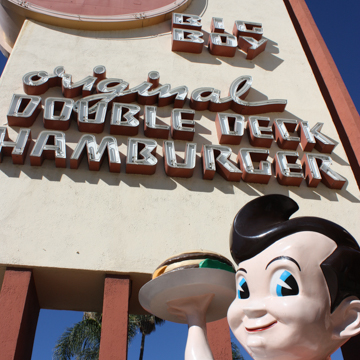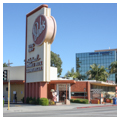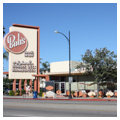Bob’s Big Boy in Burbank is a significant example of postwar coffee shop design in Los Angeles, as well as the oldest remaining Bob’s family restaurant in America. The design, with its elongated, horizontal roofline and statue of the Bob figure lifting a hamburger into the air, is one of the most iconic in Los Angeles. As Los Angeles’s automobile culture exploded in the post–World War II period, drive-in coffee shops, often with car hops providing car-side service, became a staple of the city’s architectural culture. Bob’s possesses an iconic status among the many designs that emerged at this time.
Bob Wian developed his first restaurant, Bob’s Pantry, in Glendale in 1936. A second was also built in Glendale, after which Wian began expanding his chain across the San Fernando Valley. Bob’s Big Boy in Burbank, which opened in 1949, was the third of his restaurants. The building strikes a dramatic pose at the intersection of Riverside and Rose drives. It is an excellent example of what came to be known as California “coffee shop modern” architecture. The restaurant’s design is transitional, incorporating Streamlined Moderne elements typical of the 1940s, such as broad, curving window walls and low-slung canopies, but also anticipating the more exuberant forms of the 1950s, such as cantilevers, striking signage, and extensive use of glass to enable visibility to the inside by passing motorists.
The building featured hallmarks of coffee shop architecture: plantings indoors and out, walls of glass that further brought the outdoors in, terrazzo sidewalks, and of course, neon. Architects from this period often designed coffee shops and other building types that catered to automobile transportation to be legible from vehicles. They developed the concept of “building as billboard,” with exuberant signage that caught the eyes of passing motorists. Bob’s was no exception, with a neon sign soaring thirty-five feet into the air. The magnificent sign was an integral part of the design and helped cement the Bob’s brand. A drive-in stood (and still stands) behind the building.
Wayne McAllister, who was hired to design Bob’s Big Boy, was respected for his innovative work on Mexico’s Hotel Agua Caliente and the first hotels on the Las Vegas Strip, including El Rancho Vegas and the Sands. McAllister designed many hotels and restaurants in Los Angeles, including Lawry’s, Van de Kamp’s, the Biltmore Coffee Shop, and Mike Lyman’s. Bob’s Big Boy in Burbank is one of his few remaining works.
The other Bob’s Big Boys of this era have not survived, and the Bob’s in Burbank may have met a similar fate. In 1992, the then owner of the restaurant proposed to demolish the building and redevelop the site. Volunteers from the Los Angeles Conservancy’s Modern and Post–World War II Committee (now known as the Modern Committee) led a successful effort to have Bob’s designated as a California Point of Historical Interest, paving the way for its preservation.
In the years since, the owners of Bob’s have used its history to their advantage. They have invested in maintaining the building’s modernist splendor and have successfully used its historic designation as a marketing tool. The restaurant thrives day and night. Drive by any Friday night, and you will see the parking lot packed with vintage cars and enthusiasts.
References
Hess, Alan. Googie: Fifties Coffee Shop Architecture. San Francisco: Chronicle Books, 1985.
Kaplan, Sam Hall. L.A. Lost and Found.New York: Crown Publisher, 1987.
Langdon, Philip. Orange Roofs, Golden Arches. London: Michael Joseph Publishers, 1986.
Liebs, Chester. Main Street to Miracle Mile. Boston: Little, Brown and Company, 1985.
Los Angeles Conservancy. 20/20/20: Highlights from Past ModCom Events and Preservation Issues. Tour booklet, 2004.
Los Angeles Conservancy. Conservancy News, May/June 1992.
McAllister, Wayne. Los Angeles Conservancy oral history project, 1992.
Moruzzi, Peter. “Bob’s Big Boy Restaurant and Sign.” Nomination for State of California Point of Historical Interest, 1992.
Nichols, Chris. The Leisure Architecture of Wayne McAllister. Layton, UT: Gibbs-Smith Publisher, 2007.



















